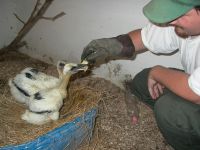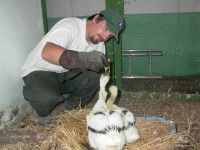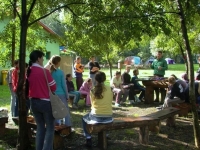 |
|
Busy days in our bird rescue center
Although most of the young storks left the nest by
mid-August, and the first flocks of storks started their journey
towards Africa around 20 August, in early September we were
still called a few times to rescue late younglings, fallen
out of the nest during heavy storms. Strong winds have regularly
blown the chicks to the ground Ė in these cases it is sufficient
to put them back to the nest or to a tree branch where cats
and dogs cannot reach them. Then the parents can take care
of the young ones, and lead them to a safe place. In certain
cases the storks needed to spend a few days in our bird rescue
center, but could be released soon after full recovery. In
the case of fracture or electrocution, veterinary treatment
and a shorter or longer period of rehabilitation is necessary
before the bird is released to the wild.
Young swallows (Hirundo rustica) are also often run
over by vehicles, because the chicks are sitting in the middle
of the road, waiting for their parents to feed them. During
migration, vehicles may even drive into the flocks of swallows
flying low, injuring several birds. Shrikes (Lanius sp.) also
prefer to feed along the roads, picking up insects hit by
road traffic. If you see an apparently disoriented, dizzy
shrike or swallow sitting in the middle of the road, you can
easily help by taking them to the roadside, so that other
vehicles donít kill them. A short rest (from a few minutes
to a few hours) in the shade and drinking water is enough
for these birds to become active and lively again.
|
|
- Copyright Nimfea TE 2001. - Design by LUPUS
- |






